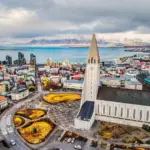
A Geographical, Cultural and Historical Portrait
Laos, an exotic nation in the heart of Southeast Asia, enchants travelers with its rich cultural heritage and stunning landscapes. Geographically located between Thailand, Cambodia, Vietnam, China and Myanmar, Laos is a country of incomparable beauty and fascinating history.. Located between coordinates 14° and 23° north latitude and 100° and 108° east longitude, this enchanting land captivates visitors with its privileged location on the Indochina peninsula.
Laos has a total area of approximately 236,800 square kilometers. It shares borders with five neighboring countries: to the north is China; to the northwest is Myanmar; to the east it borders Vietnam; to the south it borders Cambodia; and to the west is Thailand.
This strategic location contributes to the country's cultural diversity, influencing not only its history but also its unique cuisine and folk traditions. Lao culture is deeply rooted in its Theravada Buddhist traditions, which play a significant role in the daily lives of Laotians.
In addition to Buddhism, a number of animist beliefs are also practiced in some regions of the country. Laotian culture is marked by vibrant festivals, traditional crafts, and a strong emphasis on spirituality.
Laos's history is rich and complex, with archaeological evidence dating back over 10,000 years. Over the centuries, the country has been ruled by several dynasties, witnessed wars and regional conflicts, and experienced French colonial influence.
How to get to Laos
There are several ways to get to Laos, depending on where you're coming from. Some options include:
- Plane: There are no direct flights from major Brazilian capitals to Luang Prabang, Laos, but there are flights with connections in other cities. You can search for flights on websites like Rome2Rio and check the available options.
- Bus: If you are coming from Thailand, for example, you can go through Thai passport control and then take a bus to Laos.
- Boat: Another common way to get to Laos is by boat up the Mekong.
It's important to remember that transportation options may vary depending on your location and specific destination in Laos. It's recommended to research in advance and check the available options to choose the best option for your trip.
what are the cities of origin for flights to Laos
Departure cities for flights to Laos may vary depending on the airline and route chosen. Some common departure cities for flights to Laos include:
- Sao Paulo, Brazil
- Bangkok, Thailand
- Hanoi and Ho Chi Minh City, Vietnam
- Doha, Qatar
- Dubai, United Arab Emirates
These are just a few possible departure cities, and there may be other options depending on availability and airline routes. It's recommended to research in advance and review the available options to choose the best option for your trip.
what are the main airlines that fly to Laos
Some of the major airlines that fly to Laos include:
- Lao Airlines: is the national airline of Laos and operates flights to destinations within the country and also to other countries in the region.
- Thai Airways: The Thai airline offers flights to Laos from Bangkok.
- Vietnam Airlines: The Vietnamese airline offers flights to Laos from Hanoi and Ho Chi Minh City.
- Qatar Airways: Qatar's airline offers flights to Laos with a connection in Doha.
- Emirates: The United Arab Emirates airline offers flights to Laos with a connection in Dubai.
It's important to remember that airline options may vary depending on your location and specific destination in Laos. It's recommended to research in advance and review the available options to choose the best option for your trip.

The geographical location of Laos
When discussing the geographical location of Laos, it is important to mention its exact coordinates and its borders with neighboring countries. Laos is situated between latitudes 14° and 23°N and longitudes 100° and 108°E. The country borders several countries in the region, including Myanmar (Burma) to the northwest, China to the north, Vietnam to the east, Cambodia to the southeast, and Thailand to the west.
Highlighting the central position on the Indochina peninsula
A notable feature of Laos's location is its central position on the Indochina Peninsula. Situated between the aforementioned neighboring countries, Laos plays a strategic role as a bridge connecting these nations.
Furthermore, its central location in the heart of the Southeast Asia gives it privileged access to regional trade routes. This strategic position at the crossroads of trade routes has also influenced significantly the story and culture of the country over the centuries.
THE interaction with cultures neighboring regions shaped Lao customs, traditions, and even the Lao language. This central position also allowed Laos to become an important tourist destination for travelers who explore the region.
Mountainous region of Laos
Laos is known for its spectacular mountainous region, which runs from north to south. Two of the main mountain ranges that run through Laos are the Annamite Range and the Truong Son Range.
The majestic Annamite Mountain Range
The Annamite Range is a stunning mountain range that stretches along the border between Laos and Vietnam. This mountain range covers a significant portion of Lao territory, offering stunning views and challenging the most experienced adventurersThe high elevations of the Annamite Range reach imposing peaks, some of which exceed 2,500 meters in height.
The lush Truong Son Mountain Range
Located in eastern Laos, the Truong Son Mountain Range is another natural wonder that contributes to the country's stunning landscapes. This range is part of the famous Cardamom Mountains and is home to several rare species of flora and fauna. The Truong Son Mountain Range's landscape is characterized by dense, lush tropical forests teeming with diverse wildlife, including Asian elephants, tigers, and playful monkeys.
Both mountain ranges offer visitors a unique experience, with challenging trails, stunning waterfalls, and the chance to explore wildlife in their natural habitat. The mountainous region of Laos is truly a nature lover's paradise, offering unparalleled opportunities to connect with the country's untouched beauty.

The Mekong River: A major waterway that runs through the country
THE Mekong River, with its 4,350 km length, plays a fundamental role in Laos. This majestic waterway bisects the country, providing an important waterway that plays a vital role in transportation and trade.
With its imposing waters and powerful currents, the Mekong River is an impressive spectacle in itself. Besides being an essential route for the transportation of goods and people, the Mekong River is also home to a rich biodiversity.
Its waters are home to a variety of aquatic species, including rare and endangered fish. Fishing is an essential activity for communities along the Mekong River in Laos, providing subsistence and livelihood for many locals.
Other significant rivers: Nam Ou and Nam Khan
While the Mekong River is arguably the star of Laos' waterways, other rivers also deserve mention in terms of historical significance and scenic beauty. Nam Ou River is one such notable example.
Rising in the mountainous province of Phongsaly In the north of the country, this meandering river flows through picturesque rocky landscapes before joining the Mekong River near the historic city of Luang Prabang. Another highlight is the Nam Khan River, which flows through the dense rainforests of Laos.
This winding, wild river is known for its clear waters and stunning scenery. Besides being a popular spot for ecotourism enthusiasts, Nam Khan It also plays an important role in local agriculture, providing water for irrigating rice fields.
These significant rivers not only provide means of transportation and livelihood, but are also important for the culture and history of Laos. Over the centuries, they have served as vital communication routes between different communities and regions of the country, thus shaping Laos' unique identity.
Major cities in Laos
Vientiane: The Enchanting Capital
Vientiane, the capital of Laos, is a city that perfectly blends French colonial charm with Laotian culture and traditions. Exploring its quiet, tree-lined streets, visitors are greeted by a unique blend of well-preserved French colonial architecture and stunning Buddhist temples.
The city's main landmark is the Patuxai, An imposing monument inspired by the Arc de Triomphe in Paris. Climbing to the top of this monument rewards travelers with stunning panoramic views of the city and the Mekong River.
Luang Prabang: A Cultural Treasure
Luang Prabang is another important city in Laos known for its rich cultural heritage. Designated a UNESCO World Heritage Site, this picturesque city is renowned for its well-preserved traditional Laotian architecture and numerous stunning temples.
Among the highlights is the Wat Xieng Thong, one of the country's most important temples, with its impressive golden facade and intricate decorative details. Furthermore, the narrow streets lined with French colonial houses make Luang Prabang a place charming to explore on foot.
Pakse: The Heart of Southern Laos
Pakse Pakse is a vibrant city located in southern Laos and serves as an ideal base for exploring the region. Here, travelers can discover the country's authentic culture by visiting local markets and sampling delicious Lao cuisine. Pakse is also a gateway to explore southern Laos's stunning natural landscapes, such as the famous Khone Phapheng Falls on the Mekong River and the Bolaven Plateau, known for its coffee plantations and stunning waterfalls.
Conclusion
Laos is a fascinating country offering a unique blend of natural beauty, rich culture, and impressive history. From the charming capital Vientiane to historic cities like Luang Prabang and Pakse in the vibrant south, there's plenty to see and do. explore and discover in Laos. French colonial architecture combined with magnificent Buddhist temples creates an enchanting atmosphere that captivates visitors.
Furthermore, the stunning mountainous landscapes with their lush rainforests and majestic rivers make this country truly unique. If you want to immerse yourself in traditional Lao culture or simply enjoy the natural wonders that the country has to offer, Laos certainly won't disappoint.
Lucas Wanderlust has a tireless spirit of adventure, always seeking new travel experiences. Fascinated by the world and the possibility of exploring unknown destinations, he fell in love with the sense of freedom and self-discovery that traveling alone provides. With a backpack on his back and a heart open to the unknown, Lucas embarks on exciting journeys, where each destination becomes a unique chapter in his life story. He gives himself body and soul to the magic of solo travel, inspiring others to follow in his footsteps and discover themselves through adventure.







